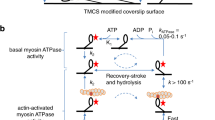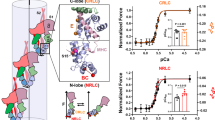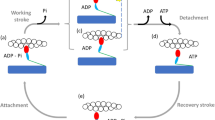Abstract
A new method is described for measuring motions of protein domains in their native environment on the physiological timescale. Pairs of cysteines are introduced into the domain at sites chosen from its static structure and are crosslinked by a bifunctional rhodamine. Domain orientation in a reconstituted macromolecular complex is determined by combining fluorescence polarization data from a small number of such labelled cysteine pairs. This approach bridges the gap between in vitro studies of protein structure and cellular studies of protein function and is used here to measure the tilt and twist of the myosin light-chain domain with respect to actin filaments in single muscle cells. The results reveal the structural basis for the lever-arm action of the light-chain domain of the myosin motor during force generation in muscle.
This is a preview of subscription content, access via your institution
Access options
Subscribe to this journal
Receive 51 print issues and online access
$199.00 per year
only $3.90 per issue
Buy this article
- Purchase on Springer Link
- Instant access to full article PDF
Prices may be subject to local taxes which are calculated during checkout





Similar content being viewed by others
References
Corrie, J. E. T., Craik, J. S. & Munasinghe, V. R. N. Ahomobifunctional rhodamine for labeling proteins with defined orientations of a fluorophore. Bioconjug. Chem. 9, 160–167 (1998).
Reedy, M. K., Holmes, K. C. & Tregear, R. T. Induced changes in orientation of the cross-bridges of glycerinated insect flight muscle. Nature 207, 1276–1280 (1965).
Huxley, H. E. The mechanism of muscle contraction. Science 164, 1356–1366 (1969).
Huxley, A. F. Muscular contraction (review lecture) J. Physiol. (Lond.) 243, 1–43 (1974).
Kabsch, W., Mannherz, H. G., Suck, D., Pai, E. F. & Holmes, K. C. Atomic structure of the actin: DNase 1 complex. Nature 347, 37– 43 (1990).
Holmes, K. C., Popp, D., Gebhard, W. & Kabsch, W. Atomic model of the actin filament. Nature 347, 44– 49 (1990).
Rayment, I.et al. Three-dimensional structure of myosin subfragment-1: a molecular motor. Science 261, 50– 58 (1993).
Dominguez, R., Freyzon, Y., Trybus, K. M. & Cohen, C. Crystal structure of a vertebrate smooth muscle myosin motor domain and its complex with the essential light chain: visualization of the pre-power stroke state. Cell 94, 559–571 (1998).
Rayment, I.et al. Structure of the actin–myosin complex and its implications for muscle contraction. Science 261, 58– 65 (1993).
Whittaker, M.et al. A35-å movement of smooth muscle myosin on ADP release. Nature 378, 748–753 (1995).
Holmes, K. C. The swinging lever arm hypothesis of muscle contraction. Curr. Biol. 7, R112–118 ( 1997).
Cooke, R. Actomyosin interaction in striated muscle. Physiol. Rev. 77, 671–697 (1997).
Goldman, Y. E. Wag the tail: structural dynamics of actomyosin. Cell 93, 1–4 (1998).
Uyeda, T. Q. P., Abramson, P. D. & Spudich, J. A. The neck region of the myosin motor domain acts as a lever arm to generate movement. Proc. Natl Acad. Sci. USA 93, 4459–4464 (1996).
Anson, M., Geeves, M. A., Kurzawa, S. E. & Manstein, D. J. Myosin motors with artificial lever arms. EMBO J. 15 , 6069–6074 (1996).
Hopkins, S. C., Sabido-David, C., Corrie, J. E. T., Irving, M. & Goldman, Y. E. Fluorescence polarization transients from rhodamine isomers on the myosin regulatory light chain in skeletal muscle fibers. Biophys. J. 74, 3093– 3110 (1998).
Sabido-David, C.et al . Orientation changes of fluorescent probes at five sites on the myosin regulatory light chain during contraction of single skeletal muscle fibres. J. Mol. Biol. 279, 387– 402 (1998).
Baker, J. E., Brust-Mascher, I., Ramachandran, S., LaConte, L. E. W. & Thomas, D. D. Alarge and distinct rotation of the myosin light chain domain occurs upon muscle contraction. Proc. Natl Acad. Sci. USA 95, 2944– 2949 (1998).
Dobbie, I.et al. Elastic bending and active tilting of myosin heads during muscle contraction. Nature 396, 383– 387 (1998).
Simmons, R. M. & Szent-Györgyi, A. G. Control of tension development in scallop muscle fibres with foreign regulatory light chains. Nature 286, 626– 628 (1980).
Moss, R. L., Giulian, G. G. & Greaser, M. L. Physiological effects accompanying removal of myosin LC2from skinned skeletal muscle fibers. J. Biol. Chem. 257, 8588–8591 ( 1982).
Penzkofer, A. & Wiedmann, J. Orientation of transition dipole moments of rhodamine 6G determined by excited state absorption. Opt. Commun. 35, 81–86 ( 1980).
Xie, X.et al. Structure of the regulatory domain of scallop myosin at 2.8 å resolution. Nature 368, 306– 312 (1994).
Jansco, A. & Szent-Györgyi, A. G. Regulation of scallop myosin by the regulatory light chain depends on a single glycine residue. Proc. Natl Acad. Sci. USA 91, 8762– 8766 (1994).
Cooke, R., Crowder, M. S. & Thomas, D. D. Orientation of spin labels attached to cross-bridges in contracting muscle fibers. Nature 300, 776–778 (1982).
Huxley, H. E. & Kress, M. Crossbridge behaviour during muscle contraction. J. Muscle Res. Cell Motil. 6, 153–161 (1985).
Linari, M.et al. The stiffness of skeletal muscle in isometric contraction and rigor: the fraction of myosin heads bound to actin. Biophys. J. 74, 2459–2473 ( 1998).
Dale, R. E.et al. Model-independent analysis of mobility and orientation of fluorescent probes in muscle fibers. Biophys. J. 76, 1606–1618 (1999).
Sabido-David, C.et al . Steady-state fluorescence polarization studies of the orientation of myosin regulatory light chains in single skeletal muscle fibers using pure isomers of iodoacetamidotetramethylrhodamine. Biophys. J. 74, 3083–3092 (1998).
Huxley, A. F. & Simmons, R. M. Proposed mechanism of force generation in striated muscle. Nature 233, 533– 538 (1971).
Irving, M.et al. Tilting of the light-chain region of myosin during step length changes and active force generation in skeletal muscle. Nature 375, 688–691 ( 1995).
Lombardi, V.et al. Elastic distortion of myosin heads and repriming of the working stroke in muscle. Nature 374, 553– 555 (1995).
Irving, M., Lombardi, V., Piazzesi, G. & Ferenczi, M. A. Myosin head movements are synchronous with the elementary force-generating process in muscle. Nature 357, 156– 158 (1992).
Funatsu, T., Harada, Y., Tokunaga, M., Saito, K. & Yanagida, T. Imaging of single fluorescent molecules and individual ATP turnovers by single myosin molecules in aqueous solution. Nature 374, 555–559 ( 1995).
Ishijima, A.et al. Simultaneous observation of individual ATPase and mechanical events by a single myosin molecule during interaction with actin. Cell 92, 161–171 ( 1998).
Warshaw, D. M.et al . Myosin conformational states determined by single fluorophore polarization. Proc. Natl Acad. Sci. USA 95, 8034–8039 (1998).
Rowe, T. & Kendrick-Jones, J. Chimeric myosin regulatory light chains identify the subdomain responsible for regulatory function. EMBO J. 11, 4715–4722 ( 1992).
Oki, M. Recent advances in atropisomerism. Top. Stereochem. 14, 1–79 (1983).
Ling, N., Shrimpton, C., Sleep, J., Kendrick-Jones, J. & Irving, M. Fluorescent probes of the orientation of myosin regulatory light chains in relaxed, rigor, and contracting muscle. Biophys. J. 70, 1836–1846 ( 1996).
Press, W. H., Teukolsky, S. A., Vetterling, W. T. & Flannery, B. P. Numerical Recipes in Fortran: The Art of Scientific Computing2nd edn (Cambridge Univ. Press, Cambridge, UK, (1992).
Chantler, P. D. & Szent-Györgyi, A. G. Regulatory light-chains and scallop myosin: full dissociation, reversibility and co-operative effects. J. Mol. Biol. 138, 473–492 (1980).
Esnouf, R. M. An extensively modified version of MolScript that includes greatly enhanced coloring capabilities. J. Mol. Graph. 15, 133–138 (1997).
Kraulis, P. J. Molscript: a program to produce both detailed and schematic plots of protein structures. J. Appl. Crystallogr. 24, 946 –950 (1991).
Merritt, E. A. & Bacon, D. J. Raster3D: photorealistic molecular graphics. Methods Enzymol. 277, 505–524 (1997).
Acknowledgements
This work was supported by the UK MRC, Wellcome Trust, NIH, MDA and AHA. We thank S. Howell for mass spectrometric analyses, M. Hirshberg and I. Dobbie for help with molecular graphics, and V. R. N. Munasinghe for technical support with BR-I2.
Author information
Authors and Affiliations
Corresponding author
Rights and permissions
About this article
Cite this article
Corrie, J., Brandmeier, B., Ferguson, R. et al. Dynamic measurement of myosin light-chain-domain tilt and twist in muscle contraction. Nature 400, 425–430 (1999). https://doi.org/10.1038/22704
Received:
Accepted:
Issue Date:
DOI: https://doi.org/10.1038/22704
This article is cited by
-
The regulatory light chain mediates inactivation of myosin motors during active shortening of cardiac muscle
Nature Communications (2021)
-
Birefringent Fourier filtering for single molecule coordinate and height super-resolution imaging with dithering and orientation
Nature Communications (2020)
-
Direct visualization of human myosin II force generation using DNA origami-based thick filaments
Communications Biology (2019)
-
Thick filament mechano-sensing is a calcium-independent regulatory mechanism in skeletal muscle
Nature Communications (2016)
-
Differential expression analysis of the broiler tracheal proteins responsible for the immune response and muscle contraction induced by high concentration of ammonia using iTRAQ-coupled 2D LC-MS/MS
Science China Life Sciences (2016)
Comments
By submitting a comment you agree to abide by our Terms and Community Guidelines. If you find something abusive or that does not comply with our terms or guidelines please flag it as inappropriate.



